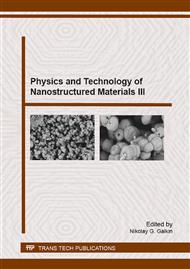[1]
Batten, Robert D., Frank H. Stillinger, and Salvatore Torquato. Classical disordered ground states: Super-ideal gases and stealth and equi-luminous materials. Journal of Applied Physics 104. 3 (2008) 033504.
DOI: 10.1063/1.2961314
Google Scholar
[2]
Barahona, Francisco. On the computational complexity of Ising spin glass models., Journal of Physics A: Mathematical and General 15. 10 (1982): 3241.
DOI: 10.1088/0305-4470/15/10/028
Google Scholar
[3]
Millane, R. P., Abhishek Goyal, and R. C. Penney. Ground states of the antiferromagnetic Ising model on finite triangular lattices of simple shape., Physics Letters A 311. 4 (2003): 347-352.
DOI: 10.1016/s0375-9601(03)00512-7
Google Scholar
[4]
Hartmann, Alexander K., and Heiko Rieger. Optimization algorithms in physics. Vol. 2. Berlin: Wiley-Vch, (2002).
Google Scholar
[5]
Hartmann, Alexander K., and Heiko Rieger, eds. New optimization algorithms in physics. John Wiley & Sons, (2006).
Google Scholar
[6]
Kirkpatrick, Scott, C. Daniel Gelatt, and Mario P. Vecchi. Optimization by simulated annealing., science 220. 4598 (1983): 671-680.
DOI: 10.1126/science.220.4598.671
Google Scholar
[7]
Berg, Bernd A., Ulrich E. Hansmann, and Tarik Celik. Ground-state properties of the threedimensional Ising spin glass., Physical Review B 50. 22 (1994): 16444.
DOI: 10.1103/physrevb.50.16444
Google Scholar
[8]
Geyer, C. J. Computing science and statistics: Proceedings of the 23rd Symposium on the Interface., American Statistical Association, New York (1991): 156.
Google Scholar
[9]
Hukushima, Koji, and Koji Nemoto. Exchange Monte Carlo method and application to spin glass simulations., Journal of the Physical Society of Japan 65. 6 (1996): 1604-1608.
DOI: 10.1143/jpsj.65.1604
Google Scholar
[10]
Binder, K. U. R. T., and W. Kob Glassy. Materials and Disordered Solids: An Introduction to their Statistical Mechanics., World Scientific, Singapore (2005).
DOI: 10.1142/5948
Google Scholar
[11]
Edwards, Samuel Frederick, and Phil W. Anderson. Theory of spin glasses., Journal of Physics F: Metal Physics 5. 5 (1975): 965.
Google Scholar
[12]
Nefedev, Konstantin, Vitalii Y. Kapitan, and Yuriy Shevchenko. The Inverse Task for Magnetic Force Microscopy Data., Applied Mechanics and Materials. Vol. 328. (2013).
DOI: 10.4028/www.scientific.net/amm.328.744
Google Scholar
[13]
Zukovic, Milan. Thermodynamic and magnetocaloric properties of geometrically frustrated Ising nanoclusters., Journal of Magnetism and Magnetic Materials 374 (2015): 22-35.
DOI: 10.1016/j.jmmm.2014.08.017
Google Scholar
[14]
De Simone, Caterina, et al. Exact ground states of Ising spin glasses: New experimental results with a branch-and-cut algorithm., Journal of Statistical Physics 80. 1-2 (1995): 487-496.
DOI: 10.1007/bf02178370
Google Scholar


